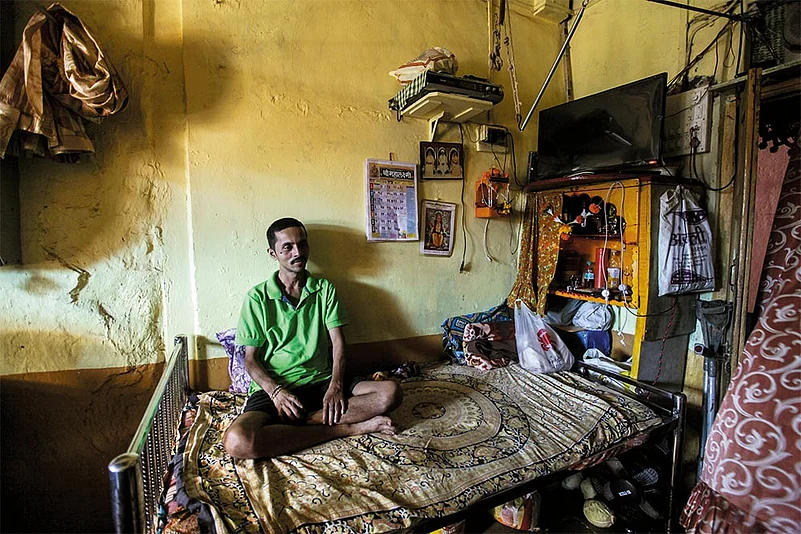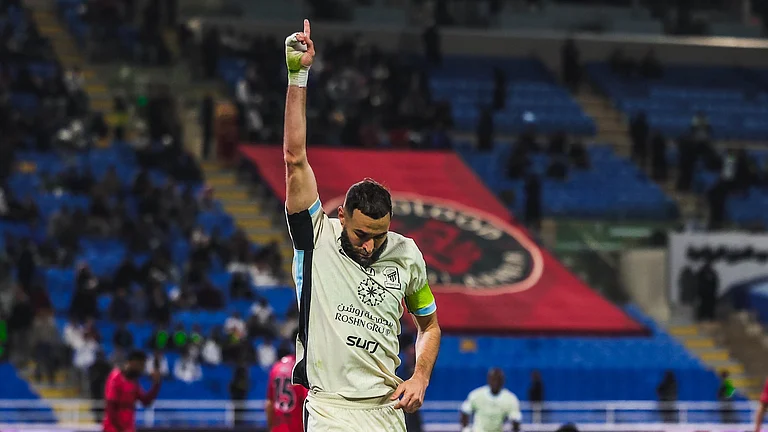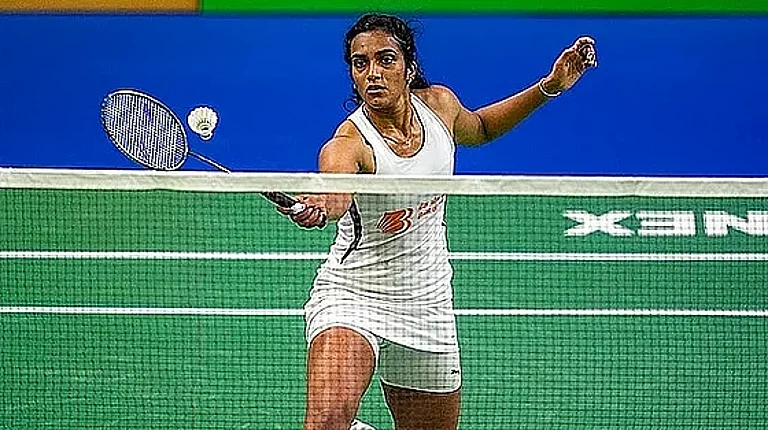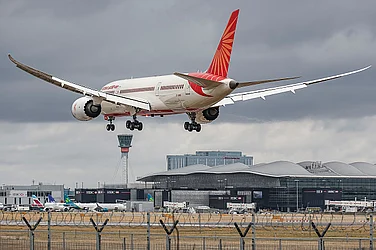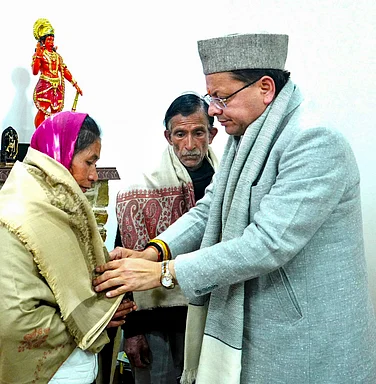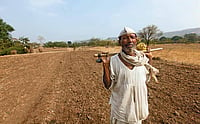Every year the mill district of Mumbai adds more swanky glass buildings, more traffic, more people. Each new, shiny apartment squeezes out an old chawl, making the lives of its dwellers that much smaller, less important and more sombre. One such creaking sprawl in the heart of Parel is Vani chawl. Displayed prominently is a notice warning the building is unsafe. A dark wooden stairway—a couple of missing steps are supported by bamboos—leads to the one-room second-floor house of Dayanand Bhadvankar, which is home to his family of five. Dayanand hasn’t stepped out of this room for six years—he has been in bed with a broken spine, a result of his heroics in the dangerous Dahi Handi festival during Janmashtami.
The Parel-Dadar area, dotted with many chawls like Vani, is a hub of public celebrations such as Dahi Handi and Ganesh Chaturthi. Every year on Janmashtami (birthday of the Hindu god Krishna), public hospitals are on high alert to receive the ‘govindas’ injured while participating in human pyramids to break pots filled with curd hanging in the air. And yet, a recent Supreme Court verdict setting the maximum legal height of the pyramids at 20 feet and the minimum age of participants at 18 has outraged the Shiv Sena, Raj Thackeray’s MNS and the organising groups popularly called mandals, who say the courts can’t curb their religious enthusiasm.
Many govindas, however, who risk their lives for upholding traditions and culture, feel secretly relieved due to the court’s order, for they know the horrors of life after a Dahi Handi accident. “Mine was the first accident in 60 years for our mandal. I was in coma for 20-25 days. Initially, the mandal, family and friends came to my aid, but it didn’t last and I had no insurance,” Dayanand, now 32, recalls. “After eight years, it is only now that I can stand with a walker, but I cannot yet step out or sit for long without help. Working is ruled out.” Moving from his bed to the washing area barely 2-3 feet away takes him five minutes.

Govindas form a pyramid to break the Dahi Handi
Dayanand’s case is repeated every year in several areas of the city. The festival has gotten bigger and the prize has shot up as high as the handis (in some mandals, it is Rs 1 crore). Often the boys are in their teens or early 20s, just about beginning their careers or family life. Take Nagesh Bhoir in Bhiwandi, who fell some 20 feet and injured his spinal cord. “No one from the mandal visited me after the accident,” he says. “We were left to fend for ourselves. I have spent more than Rs 20 lakh on multiple surgeries. The doctors had given up hope, but I survived. I don’t care if they put up 5 or 10 levels in the pyramid, but how will they ensure treatment and protection for the govindas?” Nagesh now runs a social media campaign and is a co-petitioner in the courts to limit the pyramids to 20 feet.
The number of accidents has come down slightly since 2014, when the Bombay High Court first came out with directions, but non-compliance, say activists, is rampant. The mandals, in contrast, say the money is drying up. Many govindas are still not insured, or only for a paltry amount.
“Safety must be a priority,” says Dr Pradeep Bhosale, former head of the department of orthopaedics at KEM Hospital. “Mostly, these boys come from poor households. No one covers for their injuries and the unfortunate ones become paraplegics.” Fractures of heel and ankle bone, hip dislocation, cervical or lumbar fractures and even head injuries are common. Many of the injured succumb to attendant complications and infections within a few months of spinal surgery and paraplegia. Activists also speak of a collective depression that afflicts the kin of paraplegic and quadriplegic patients because of their daily struggles with little hope of any recovery.
Sandeep Hasolkar, a father of three, died four months after a govinda fell on his neck when a pyramid came crashing in 2012. “Just thinking about that day sends a shiver down my spine,” says his wife Snehal. “He had gone out to get a birthday cake for our daughter and went along with a friend to join the pyramid. During the months he was on his death bed, he kept saying he regrets that one moment.”
Snehal took up a job with a jewellery unit to makes ends meet after the death of her sole-breadwinner spouse, who was a security guard at the Royal Bank of Scotland (RBS). He was able to get help from Meera Sanyal, AAP leader and former director of the RBS. “We did everything we could, but the doctors told us Sandeep wasn’t going to make it,” says Sanyal.

Snehal’s husband was killed when a govinda fell on him
Most survivors cannot afford a nurse to clean and carry them and live in disabled-unfriendly chawls. “The World Health Organisation lists spinal cord injury as the most devastating disability in the world. Many die due to complications like bedsores, respiratory issues or urine infections,” says Dr Ketna Mehta of the Nina Foundation. “Dahi Handi should be categorised as an adventure sport and safety equipment such as helmet, lumbar jacket and netting must be made mandatory.”
Swati Patil, from Utkarsh Mahila Samajik Sanstha, points to the financial lure of these festivals. “Apart from height and age restrictions, the court order also talks about auditing these celebrations,” she says. “There should be a ward-wise study of expenses.”
The old-timers are disappointed with the present nature of the festival as well as the proposed changes. “It has become too commercial. The fun is gone,” says a mandal member who doesn’t want to be named. “Earlier, it wasn’t all about the prize money. There would be fewer dahi handis and a bigger throng around the govindas. So the human cushion used to be bigger. Even if we fell, the injuries were rarely life-threatening.”
That, perhaps, is the heart of the matter. With politically affiliated mandals with big sponsors, the festival is now a spectacle for the 24x7 infotainment industry with filmstars lining up to appear on the stage. Bollywood films, with the hero climbing improbable heights to break the handi, usually picturised over a rousing song with all the fans egging him on and heroine clapping with delight, hasn’t helped either. Nowadays, groups of govindas are loaded into trucks and carried on bikes from one handi to the other. The spectacle goes on until late in the night, with the weary and exhausted participants staking their lives for the prize. It is no longer about local communities coming together to have fun.
No wonder, the fight over the Dahi Handi regulations has become an ugly socio-political battle. “The court verdict shouldn’t hurt local sentiments. Anyone who sees the victims up close won’t oppose the restrictions,” says Sanyal. A friend of Dayanand says, “We participate for the love of the tradition, but there is no one to look after us.” Certainly not the political parties, too eager to be seen as upholding Maratha honour. The likes of Raj Thackeray have declared the SC order won’t be complied with, even as there’s no dearth of govindas pledging support to their mandals and practising after work hours in neighbourhood maidans, hoping to make it to the top, get some cash prizes—and hoping against hope the pyramid doesn’t crumble.






